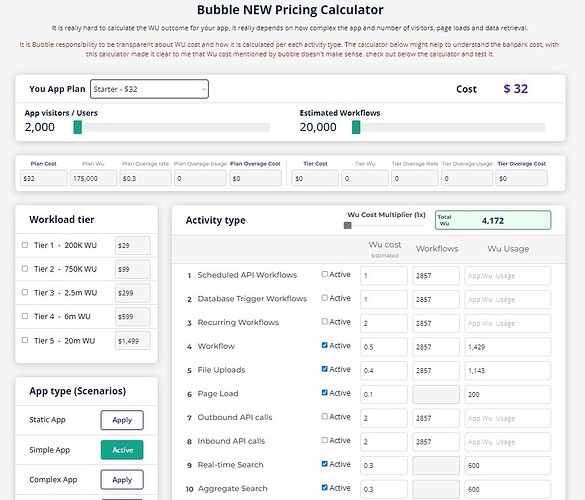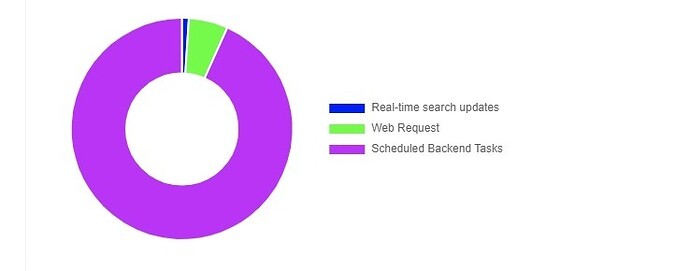Post your pie?
I built a calculator to help understand the Wu more and how much it might cost per activity type.
I tried to replicate the consumption of my app on the calculator and I got way way less Wu than I actually have on my app. I think my app should consume Wu in range 600K - 800K not 18 Million
Play with it and share your feedback.
I’ve shared my test results for some simple actions:
Some interesting things I’ve discovered:
- Different users can have different WU cost for same actions (???)
“create a new thing” action. I’ve performed 6 tests and got ~ 12.5-13 WU in “clean” WF workload (excluding page load, data fetching and API WUs). @dorilama made at leat 10 tests and he has ~8.8 WU in WF workload. So that makes no sense to me, how are we supposed to optimise anything when we have different WUs cost results while testing same action? - Price per thing creation:
2.1 1 WF with a single “Create a new thing” action → ~13 WF WU per thing creation
2.2 1 WF with 2 subsequent “Create a new thing” actions → ~10.5 WF WU per thing creation
2.3 1 WF with 20 subsequent “Create a new thing” actions → ~8.6 WF WU per thing creation - Occasional data fetching. While testing empty page (no elements, no wfs, nothing on page load) load. First test → 25.28 WU for data fetching (for what? no searches, no data requests…). All other tests showed 0-0.4 WU for the same.
Tried it and I think it’s awesome!
Though at this stage there’s barely any information and from the information that I’ve read, each WU factor is affected by other variables like volume and size of data fetched.
Them API workflows. Looking at the pies going around, it makes the WU cost of API workflows seem like a very nasty decision by Bubble.
Fun fact in case you didn’t know; you’re paying extra WU cost for scheduling the API calls.
Are these client-side workflows safe? AFIK it is best not to expose them to the browser.
Yes. Because it works just like bubble workflows but then using xano
Great questions @ihsanzainal84 - if you get a good response to some of these, please share in this thread.
Nice work getting this out so fast. Played with it and its quite interesting. Perhaps you could also share a short Loom video of the logic you are using to get the final cost.
Thanks.
I’m saying this is the way to go. This also makes it easier to not be married to bubble as your UI builder anymore. Know what I mean, jellybean?
Ok so, after building the calculator app today, I noticed few interesting things with Workload units of this app.
- The app uses only input fields on the page, no database data at all, no do search for.
- I see big chunk of the workload coming from API (13.6%) Not sure Why!
- The app has 0 Plugins installed.
- The app has 0 database records.
- Around 615 Wu (82%) coming from page load with no data, just page load.
- The calculator links got around 49 clicks in total and plus me building and testing which was around 170 Wu before posting to forum.
- Giving all of the above. every page load cost around 0.4 Wu, note that this page has 0 data types and no connection to database.
*Fetching data seems to be of the current user cookie thing.

Also a video of the editor
View Video
Every time a page is loaded, bubble does a api call to get the initial page data. I think thats the API.
Interesting topic!!!
Nahhh… not worth it!
do you know how many times the page was loaded?
From my tests loading an empty page (from a private browsing window) with nothing is around 2WU
Here’s an update from support:
Why are there WU costs related to deleted pages?
Was the page deleted within the last 30 days? If so, it will be reflected in metrics even though it is currently deleted.
Why is there an API WU cost in my sandbox app when I don’t even have the API connector installed? Are there native Bubble factors involved that? Also why can I not drill down into the API to find out more?
Do you leverage the Bubble API or backend workflows? If so, this is likely the reason for the presence of API in your usage. We’re working on making these charts more granular in the short term future so you can do a deeper dive into usage!
Why is there an individual data request when I am not requesting any data from my database?
For this, we’d have to take a closer look at the workflow itself. Let us know if you would like further assistance and I can put you in touch with our team specialized in optimization.
When doing a search of things with the :first item operator, does the result of the search constraints count toward the total WU? Or does it only cost that 1 item fetched?
If the former, then does that mean the more records in my data type the higher the WU cost even if I only want the first item?
I’m checking on the answer with the team and will get back to you as soon as possible!
Will calling an API as a clientside JavaScript action, using the Toolbox Plugin, cost me WU?
This depends on whether the workflow as a whole runs on the server, or client-side- for example, if the workflow action
How would using plugins affect my WU? What part of plugins will cost more WU?
This would depend on what the plugin provides and whether it performs something that contributes toward WU, which can be found in this article. The actions a plugin performs outside of the Bubble server will not count toward your WU. Things to look out for would primarily be the actions in which the plugin is involved inside the app itself.
Is there a roadmap for native optimization features or workflow actions?
Optimizing Bubble’s performance is a top priority for the team; our VP of Marketing discusses some of the short term optimization plans in this forum post, if you have a chance to take a look!
Last question: Why does WU capacity not scale equally to the price of plans?
The price of plans is based on the feature access associated with each, which we are considering a separate entity from the scale of the WU Tiers. So the rationale between the pricing intervals of Starter, Growth, etc is based on features such as the number of collaborators, development branches, and features of that nature.
It does look like the 5th answer got cuttoff, I’ll check back with support.
I’m seeing WU’s being used for page loads of pages that have never existed.
But i’m not seeing any pages loads for my 404 page. 
I’m quite sure that’s what those are. Your site would have thrown 404, but the URL of the get request is what’s shown in the WU chart.
Pretty shocked by the response…
I think I want to curl up in a ball and die! I quit my job a year ago to build and run this app fulltime with the hope of creating a viable business for myself. based on the new pricing my app will go from $29 a month to $299 a month. Worse thing is that my app is now starting to get popular and my app is heavily search based as it is a catalogue app that users need to search regularly on.
Any suggestions on alternative no-code platforms that I can move to that are more sustainable for me?





